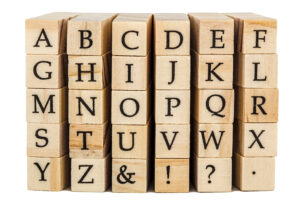
Serif fonts have long been associated with elegance, sophistication, and readability, making them a popular choice for blog designs that aim to convey professionalism and style. These fonts are distinguished by their small lines or strokes attached to the end of letters, known as “serifs.” In the world of blogging, where aesthetics and content presentation matter greatly, choosing the right serif font can elevate the reader’s experience, create a sense of trust, and give a polished look to your blog. In this article, we will explore the best serif fonts for sophisticated blogs, how to select them, and how they can enhance your blog’s visual appeal.
Serif fonts are typefaces that feature small lines or embellishments (serifs) at the ends of their letterforms. These fonts have been widely used in print media, including books, newspapers, and magazines, because of their legibility in longer blocks of text. However, in the digital age, serif fonts continue to thrive due to their timeless, classic appearance. They are often used in blogs that seek to exude professionalism, trustworthiness, or a refined, editorial-like aesthetic.

The origins of serif fonts date back to Roman antiquity, where the first forms of serif lettering were carved into stone. Over time, the serif evolved and became a staple of printed typefaces. By the 15th century, when the printing press was invented, serif fonts like Garamond and Times New Roman were developed to meet the needs of books and other printed materials. Today, while digital design has embraced sans-serif fonts, serif fonts still hold their place as icons of sophistication and clarity.
Blogs, particularly those focused on thought leadership, lifestyle, fashion, or academic subjects, can benefit from the use of serif fonts for several reasons. Let’s explore why serif fonts are an excellent choice for blogs aiming for a sophisticated look.
One of the key strengths of serif fonts is their high readability, especially in longer texts. The small strokes on the letters help guide the reader’s eye along each line of text, making it easier to follow and less fatiguing to read. This makes serif fonts an ideal choice for blogs that publish long-form content or articles. The structured and formal nature of serif fonts provides an air of professionalism, making them suitable for academic or journalistic writing.
Serif fonts bring a sense of gravitas and tradition to a blog. Their association with print media and history gives blogs a professional tone, making them ideal for topics like finance, law, education, and high-end lifestyle. Their timeless appeal ensures that your blog won’t look outdated as design trends come and go.
Serif fonts, especially in combination with sans-serif fonts, help establish a clear visual hierarchy in your blog. The contrast between serif fonts in headers and sans-serif fonts in body text can create a well-organized, visually appealing layout. This makes it easier for readers to navigate your blog and digest information efficiently.
There are countless serif fonts to choose from, each with its own unique character and use cases. Below are some of the most popular and sophisticated serif fonts that are perfect for elevating the design of your blog.
Garamond is one of the oldest serif fonts, dating back to the 16th century. Known for its elegance and readability, Garamond is often used in editorial designs and blogs that want to emulate the look of high-end magazines or literary publications. Its classic style makes it a perfect choice for blogs focusing on culture, history, and academia.
Georgia is a modern serif font designed specifically for digital screens. Its large x-height makes it highly readable on both desktop and mobile devices, while its formal yet friendly appearance is well-suited to blogs on topics like business, lifestyle, and technology. Georgia’s versatility ensures that it looks great in both body text and headings.
Times New Roman is perhaps one of the most recognized serif fonts worldwide. While it may seem conventional, it remains a solid choice for bloggers who want to convey professionalism, particularly in academic, legal, or editorial contexts. Its crisp and clean design ensures that the focus remains on the content without distraction.
Merriweather is a modern serif font designed to be highly readable on digital screens, which makes it a great option for web content. With its slightly condensed letterforms, it can fit more text in a limited space without sacrificing legibility. Its warm, approachable style works well for blogs focused on personal growth, wellness, and education.
Playfair Display is a serif font with high contrast between thick and thin strokes, making it perfect for headlines and titles. Its fashionable and elegant design is ideal for luxury blogs, fashion, interior design, and beauty content. Paired with a simpler sans-serif for body text, Playfair Display can bring a high-end feel to any blog.
Selecting the right serif font for your blog can greatly enhance the visual experience for your readers. However, with so many fonts available, it can be difficult to know where to start. Below are some key considerations to help you choose the perfect serif font for your blog.
The theme and tone of your blog should guide your font selection. For instance, if your blog focuses on academic research, a traditional serif font like Times New Roman or Garamond would be appropriate. On the other hand, a fashion blog might benefit from a more stylish and modern serif like Playfair Display or Baskerville.
While it’s important to choose a font that reflects your blog’s identity, it’s equally important to ensure that the font is easy to read. Serif fonts with high contrast or decorative elements might look visually appealing but could be challenging to read in long paragraphs. Make sure to test your font choices in various sizes to ensure they maintain legibility.
Serif fonts often work best when paired with complementary fonts. A common design practice is to use a serif font for headings and titles and a sans-serif font for body text. This combination can create a nice balance between formal and casual elements, ensuring your blog remains stylish yet readable.

Make sure to test how your chosen serif font appears on different devices, including mobile phones, tablets, and desktops. Some fonts may look great on large screens but become difficult to read on smaller screens. Fonts like Georgia and Merriweather, which are designed for digital use, can provide consistency across platforms.
In conclusion, serif fonts offer a timeless and sophisticated appeal that can elevate the design of any blog. Whether you are running a fashion blog, a professional platform, or an academic site, the right serif font can create a sense of trust, readability, and aesthetic pleasure for your audience. By choosing popular fonts like Garamond, Georgia, or Playfair Display, and considering factors such as your blog’s tone, readability, and cross-device compatibility, you can create a visually stunning blog that resonates with readers and stands the test of time.